nasa
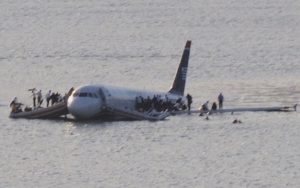
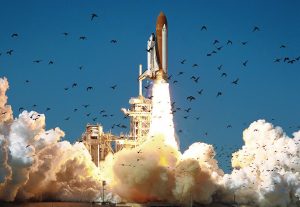 Most of us have heard about the bird strike that brought down US Airways Flight 1549 in the Hudson River off Manhattan, after both engines were disabled by a bird strike on January 15, 2009. The birds were just flying along…minding their own business. Then suddenly, there was a plane…right in their path. So my thought is what were the birds thinking in that instant before their death. I don’t mean to sound morbid, but I do believe animals can think, and like humans, they might be thinking, “Oh boy…this is it!!” And it was.
Most of us have heard about the bird strike that brought down US Airways Flight 1549 in the Hudson River off Manhattan, after both engines were disabled by a bird strike on January 15, 2009. The birds were just flying along…minding their own business. Then suddenly, there was a plane…right in their path. So my thought is what were the birds thinking in that instant before their death. I don’t mean to sound morbid, but I do believe animals can think, and like humans, they might be thinking, “Oh boy…this is it!!” And it was.
In the world of NASA Kennedy Space Center in Florida, birds are a part of the territory too. NASA usually takes their feathered intruders in stride, and in turn, the birds provide an extra level of interest in launch photography. For NASA the bird problem can be largely attributed to the nearby Merritt Island National Wildlife Refuge’s 310 species of birds that love to swoop through for a visit. Most of the time it’s no big deal, but when they start poking around during a launch, it can be a bit more problematic.
Many of the bird species are not a problem, but one particular type of bird is causing concern for NASA…vultures. In 2005, they had a bird hit Discovery’s external tank during the launch. A vulture’s average weight ranges from 3 to 5 pounds, so a strike at a critical point on the shuttle…like the nose or wing leading thermal protection panels could cause catastrophic damage to the vehicle. The foam chunk that fatefully struck Columbia’s wing in 2003 weighed only 1.7 pounds. Even with the space shuttle launches cancelled, there are still launches at the Kennedy Space Center, and something needs to be done to protect the astronauts, rockets, and equipment, as well as the birds from the harm that occurs when nature collides with NASA. That said, NASA designed special radar to track any vultures around Launch Pad 39B during the countdown to liftoff of Space Shuttle Discovery on mission STS-121. NASA is also trying to clean up anything, like “roadkill” around Kennedy in an effort to prevent the birds being drawn to the area. They are removing the easy food source that keeps the birds around.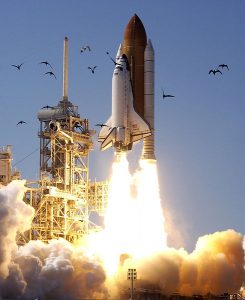

Vultures search for food during the day, often circle high into the Florida sky, floating on the thermal gradients, getting a birds-eye view of food sources. To mitigate the danger, an avian radar system known as “Aircraft Birdstrike Avoidance Radar” has been installed to track their movement around the launch area and relay the data to launch control experts. The system was developed by a company called DeTect of Panama City, Florida, which primarily has served the commercial aviation industry and the military. Hopefully the radar can give the launch team locations in real-time so decisions can be made to avoid bird strikes in the future.
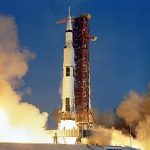
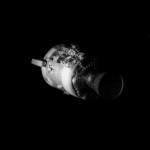 On this the 50th anniversary of the Apollo 13 near disaster, I am reminded of the tenacity of the human spirit. The space program was becoming commonplace, and while the plan was to televise parts of the mission, the networks decided not to play the program, because space travel had become mundane…nothing new happened, and it was then, as it is now, that sensationalism sells news. Then, completely unexpectedly, everything changed. Our astronauts were in serious trouble. After the explosion that would render the space capsule useless, and those famous words were uttered, “Houston, we’ve had a problem here,” everyone wanted to follow this very serious situation. Now it was important to watch this previously mundane mission.
On this the 50th anniversary of the Apollo 13 near disaster, I am reminded of the tenacity of the human spirit. The space program was becoming commonplace, and while the plan was to televise parts of the mission, the networks decided not to play the program, because space travel had become mundane…nothing new happened, and it was then, as it is now, that sensationalism sells news. Then, completely unexpectedly, everything changed. Our astronauts were in serious trouble. After the explosion that would render the space capsule useless, and those famous words were uttered, “Houston, we’ve had a problem here,” everyone wanted to follow this very serious situation. Now it was important to watch this previously mundane mission.
The reactions, both before and after the explosion, are completely normal. People tend to look for the excitement is life to keep them interested…good or bad excitement. We find ourselves glued to the television after a disaster, hoping to learn something new. We are the same way about exciting good news, but with the Apollo 13 mission, the news of another lunar landing wasn’t new. We had seen it all before…until it all went wrong. The NASA families, and especially the families of the astronauts in trouble, were less than impressed by the sudden interest in their men onboard Apollo 13, and I can understand why. It seemed no one cared, until it went wrong. Yes, the people wanted the men home safely, but it was the drama that drew them to the situation, and finally, had us thinking about something outside of ourselves. Yes, all turned out great in the end, and the men came home safely, but the space program didn’t increase in importance in our lives…until the next disaster, that is.
It’s not that we, the people are not interested in anything that doesn’t keep us riveted to our chair, staring at the news, but that we tend to overlook much of what is going on around us, until it affects us. Take the Coronavirus for example. Diseases come and go, and provided it doesn’t impact us or the ones we love, most diseases come and go with little notice by the general public. That’s why pandemics are so widely televised and watched. The affect everyone, in one way or another. We might know someone who has it, or have people in the disease hotspots, or have someone working in healthcare who is dealing with it, or we might just find ourselves drawn to the situation because we are one nation living in one world. Whatever our reason, suddenly we are interested, and that’s when we step outside of ourselves.
I have been very moved by the response of the American people during the Coronavirus Pandemic. We have seen people making medical masks for the hospitals, collecting food for those in need, and going to the store for those who can’t. We have seen people cheering the first responders, healthcare workers, grocery store workers, and food workers, who have all stayed on the job, to keep things running smoothly. We have other businesses that have had to stay open too…the banks, insurance agencies, sanitation workers, street workers, agriculture workers, military and national guard members, and a number of others. All these people are heroes. We could not stay at home, like we have been asked to do, if these heroes didn’t get up and go to work every  day, despite personal risks. As President Trump has said, we are at war…fighting an invisible enemy, so anyone who leaves their house takes a certain measure of risk of contracting the disease. Those who go to work are the bravest people we have. We owe them so much. We have also seen many people who have changed up their entertainment mediums, and have started giving free concerts on the internet. Churches have started streaming services. Choirs from many other areas have put together “social distancing” performances. All these things are designed to keep our spirits up…something we all need in these trying times. The thing that I find the most amazing is how we have all came together, how we stepped outside of ourselves to make a difference.
day, despite personal risks. As President Trump has said, we are at war…fighting an invisible enemy, so anyone who leaves their house takes a certain measure of risk of contracting the disease. Those who go to work are the bravest people we have. We owe them so much. We have also seen many people who have changed up their entertainment mediums, and have started giving free concerts on the internet. Churches have started streaming services. Choirs from many other areas have put together “social distancing” performances. All these things are designed to keep our spirits up…something we all need in these trying times. The thing that I find the most amazing is how we have all came together, how we stepped outside of ourselves to make a difference.
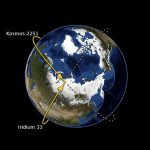 When we think of space, we picture things floating slowly and peacefully along…or at least I do, but the reality is that most things in space are moving quite fast, and along a specific trajectory. While it seems quite chaotic when you think about all the things that are floating around out there, for the most part, it all moves along in a completely organized manner…for the most part.
When we think of space, we picture things floating slowly and peacefully along…or at least I do, but the reality is that most things in space are moving quite fast, and along a specific trajectory. While it seems quite chaotic when you think about all the things that are floating around out there, for the most part, it all moves along in a completely organized manner…for the most part.
For things in space to change course, there must be something that interferes with the trajectory…a planet that gets in the way, a new piece of space junk that crosses its path, or a satellite that is falling out of orbit. Even with as much “stuff” as exists in space, these are not common occurrences…or at least not as common as you might think. Nevertheless, on February 10, 2009, two communications satellites…the active commercial Iridium 33 and the derelict Russian military Kosmos-2251…accidentally collided at a speed of 26,000 miles per hour and an altitude of 490 miles above the Taymyr Peninsula in Siberia. That speed puts the collision in the hypervelocity category…in fact, very much so. Hypervelocity is very high velocity, listed as 6,700 miles per hour, or more. At 26,000 miles per hour, this collision more than qualified. That kind of speed is shocking…at least in my mind, and the collision must have been horrific. While there had been other collisions in space, this was the first time a hypervelocity collision occurred between two satellites. Prior to that, all accidental hypervelocity collisions had involved a satellite and a piece of space debris.
The collision occurred at 16:56 UTC, which is the time standard commonly used across the world. The world’s timing centers have agreed to keep their time scales closely synchronized, therefore the name Coordinated Universal Time. The collision destroyed both the Iridium 33 and Kosmos-2251. The Iridium satellite was operational at the time of the collision. Kosmos-2251 had gone out of service in 1995. Kosmos-2251 had no propulsion system, and was no longer actively controlled. Had it been actively controlled, they might have guided it out of harm’s way. NASA initially estimated the debris at 1,000 pieces larger than 3.9, and many smaller pieces, but in reality the US Space Surveillance Network had cataloged 2,000 large pieces by July 2011. They thought the International Space Station, which orbits at about 270 miles below the collision course, was safe, but one piece came within 130 yards at one time, making for a tense few hours.
In the days following the first reports of the incident in 2009, a number of reports of phenomena in the US states of Texas, Kentucky, and New Mexico were attributed to debris from the collision. NASA and the United States Strategic Command, which tracks satellites and orbital debris, did not announce that any debris had 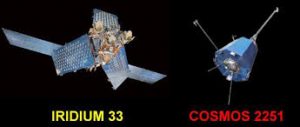 entered the atmosphere at the time and reported that these phenomena were unrelated to the collision. Still, things like sonic booms heard by witnesses in Kentucky, on February 13, 2009 made no sense in any other scenario. Then, the National Weather Service issued an information statement alerting residents of sonic booms due to the falling satellite debris. The Federal Aviation Administration also released a notice warning pilots of the re-entering debris. However, some reports include details that point to these phenomena being caused by a meteoroid shower rather than debris. A very bright meteor over Texas on February 15, 2009, was mistaken for re-entering debris. By December 2011, many pieces of the debris were in an observable orbital decay, moving towards Earth, and were expected to burn up in the atmosphere within one to two years. By January 2014, 24% of the known debris orbits had actually decayed. In 2016, Space News listed the collision as the second biggest fragmentation event in history, with Kosmos-2251 and Iridium 33 producing respectively 1,668 and 628 pieces of cataloged debris, of which 1,141 and 364 pieces of tracked debris remain in orbit as of January 2016.
entered the atmosphere at the time and reported that these phenomena were unrelated to the collision. Still, things like sonic booms heard by witnesses in Kentucky, on February 13, 2009 made no sense in any other scenario. Then, the National Weather Service issued an information statement alerting residents of sonic booms due to the falling satellite debris. The Federal Aviation Administration also released a notice warning pilots of the re-entering debris. However, some reports include details that point to these phenomena being caused by a meteoroid shower rather than debris. A very bright meteor over Texas on February 15, 2009, was mistaken for re-entering debris. By December 2011, many pieces of the debris were in an observable orbital decay, moving towards Earth, and were expected to burn up in the atmosphere within one to two years. By January 2014, 24% of the known debris orbits had actually decayed. In 2016, Space News listed the collision as the second biggest fragmentation event in history, with Kosmos-2251 and Iridium 33 producing respectively 1,668 and 628 pieces of cataloged debris, of which 1,141 and 364 pieces of tracked debris remain in orbit as of January 2016.
Contrary to what was expected, a small piece of Kosmos-2251 satellite debris safely passed by the International Space Station at 2:38 am EDT, Saturday, March 24, 2012, at a distance of just 130 yards. As a precaution, ISS management had the six crew members on board the orbiting complex take refuge inside the two docked Soyuz rendezvous spacecraft until the debris had passed. It was a tense time…not knowing if the debris would hit them or miss them. It is not unusual to see two satellites approach within several miles of each other. In fact, these events occur numerous times each day. It’s a challenge to sort through the large number of potential collisions to identify those that are of higher risk. Precise, up-to-date information regarding current satellite positions is difficult to obtain. In fact, the calculations made by CelesTrak had expected these two satellites to miss by 1,916 feet…not a huge distance, but had it been right, it would have been enough.
Planning an avoidance maneuver with due consideration of the risk, the fuel consumption required for the maneuver, and its effects on the satellite’s normal functioning can also be challenging. John Campbell of Iridium spoke at a June 2007 forum discussing these tradeoffs and the difficulty of handling all the notifications they were getting regarding close approaches, which numbered 400 per week for approaches within three miles for  the entire Iridium constellation. He estimated the risk of collision per conjunction as one in 50 million…oops!! That was just a little bit off.
the entire Iridium constellation. He estimated the risk of collision per conjunction as one in 50 million…oops!! That was just a little bit off.
This collision and numerous near-misses have renewed calls for mandatory disposal of defunct satellites by deorbiting them, or at the very least, sending them to a graveyard orbit, but no such international law exists at this time. Nevertheless, some countries have adopted such a law domestically, such as France in December 2010. The United States Federal Communications Commission requires all geostationary satellites launched after March 18, 2002, to commit to moving to a graveyard orbit at the end of their operational life. It’s a start.
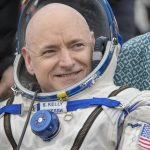 I’ve often thought, upon waking from a sleeping position that my body didn’t particularly like, that it would be wonderful to sleep in an anti-gravity machine. Maybe I would sleep better, and maybe I wouldn’t, but the reality is that it’s quite probable that man was not really intended for long periods of anti-gravity. While a few hours of blissful sleep, followed by no aches and pains from pillow or mattress, might be something wonderful to experience, I can fully see, after reading about the astronaut, Scott Kelly, who at least for a time spent the longest number of consecutive days at the International Space Station, in a state of anti-gravity. That number was 340 days.
I’ve often thought, upon waking from a sleeping position that my body didn’t particularly like, that it would be wonderful to sleep in an anti-gravity machine. Maybe I would sleep better, and maybe I wouldn’t, but the reality is that it’s quite probable that man was not really intended for long periods of anti-gravity. While a few hours of blissful sleep, followed by no aches and pains from pillow or mattress, might be something wonderful to experience, I can fully see, after reading about the astronaut, Scott Kelly, who at least for a time spent the longest number of consecutive days at the International Space Station, in a state of anti-gravity. That number was 340 days.
My first thought was of how gentle that must have been to his body, and maybe I would be right, but at some point, Kelly had to return to Earth. The experiment that he was a part of was over. The idea was to learn what the effects on the human body were in a prolonged state of 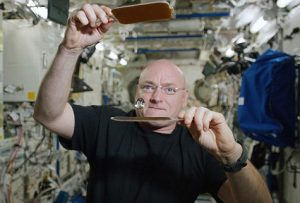 anti-gravity. It really hadn’t occurred to me that there might be any adverse effects, but apparently I would have been wrong. Among the complaints Kelly spoke of, one of the worst was a burning rash all over his skin. I wondered what might have caused that. The answer amazed me. The rash appeared on his back, legs, arm, and anywhere else where his body has touched the bed he now sleeps in. Not only is there a rash, but it is inflamed, feeling hot to the touch. Okay, my body may not like my mattress and pillow all the time, but it doesn’t give me a burning rash, so maybe it’s not so bad after all, and since I only occasionally wake up achy from my night’s sleep, I’ll deal with it.
anti-gravity. It really hadn’t occurred to me that there might be any adverse effects, but apparently I would have been wrong. Among the complaints Kelly spoke of, one of the worst was a burning rash all over his skin. I wondered what might have caused that. The answer amazed me. The rash appeared on his back, legs, arm, and anywhere else where his body has touched the bed he now sleeps in. Not only is there a rash, but it is inflamed, feeling hot to the touch. Okay, my body may not like my mattress and pillow all the time, but it doesn’t give me a burning rash, so maybe it’s not so bad after all, and since I only occasionally wake up achy from my night’s sleep, I’ll deal with it.
Among the other complaints Kelly suffered, were feelings of nausea (possibly a vertigo type of an issue), a  stumbling gait from legs that are not used to gravity (Kelly’s vestibular system was trying to readjust to Earth’s gravity…like learning to walk all over again), an altered sense of gravity (waking up feeling like he is upside down), muscle atrophy from muscles that weren’t used, an all-over body ache from the pressures of gravity, and a constant grogginess, just to name a few. Of course, short -term anti-gravity such as I would experience by sleeping in an anti-gravity machine, would be very unlikely to produce any adverse conditions, like prolonged anti-gravity did in Kelly. Nevertheless, because our bodies are designed to work with gravity, I suppose my sleep idea is not such a good idea after all. At least, I don’t think it is one that I am willing to take a chance on.
stumbling gait from legs that are not used to gravity (Kelly’s vestibular system was trying to readjust to Earth’s gravity…like learning to walk all over again), an altered sense of gravity (waking up feeling like he is upside down), muscle atrophy from muscles that weren’t used, an all-over body ache from the pressures of gravity, and a constant grogginess, just to name a few. Of course, short -term anti-gravity such as I would experience by sleeping in an anti-gravity machine, would be very unlikely to produce any adverse conditions, like prolonged anti-gravity did in Kelly. Nevertheless, because our bodies are designed to work with gravity, I suppose my sleep idea is not such a good idea after all. At least, I don’t think it is one that I am willing to take a chance on.
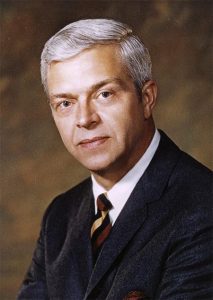 With the arrival of the 50th anniversary of the landing on the moon, on July 20, 2019, many people have been reviewing old footage and books about the event. I came across a book that caught my eye on Audible. The book, The Man Who Knew The Way To The Moon, by Todd Zwillich wasn’t exactly about the moon landing, but rather how it became possible. The book begins with Russia beating the United States to the punch when they sent a man Yuri Alekseyevich Gagarin, into space on April 12, 1961. As short as the flight was…just 89 minutes…it was still an embarrassment to the United States who felt they should have been first.
With the arrival of the 50th anniversary of the landing on the moon, on July 20, 2019, many people have been reviewing old footage and books about the event. I came across a book that caught my eye on Audible. The book, The Man Who Knew The Way To The Moon, by Todd Zwillich wasn’t exactly about the moon landing, but rather how it became possible. The book begins with Russia beating the United States to the punch when they sent a man Yuri Alekseyevich Gagarin, into space on April 12, 1961. As short as the flight was…just 89 minutes…it was still an embarrassment to the United States who felt they should have been first.
In answer to the Soviet space flight, President Kennedy challenged NASA to put a man on the moon before the end of the decade. NASA sort of panicked. Yes, they had been thinking about a moon landing…and some remote point down the road, but they were nowhere near ready to go them by the end of the decade. Nevertheless, they began to explore ideas to make it happen. One of those people who had been considering a way to make the landing possible. By this time, no one doubted the ability to go into space, and to safely return to earth. Landing on the moon was a different story.
The widely accepted method of landing on the moon was to have the original rocket back onto the moon, carrying enough fuel to take off again and return to Earth. A man named John Houbolt thought that was…well, simply impossible. Now, I’m no aeronautical engineer, like Houbolt was, and maybe I have the advantage of  knowing about the past space exploration victories, but when I think about three astronauts backing a 90 foot high, fully fueled rocket onto the moon…all I can say is, “That’s ludicrous!!” People often say that an idea doesn’t take a rocket scientist, and it this case, maybe it shouldn’t be a rocket scientist, but rather an aeronautical engineer.
knowing about the past space exploration victories, but when I think about three astronauts backing a 90 foot high, fully fueled rocket onto the moon…all I can say is, “That’s ludicrous!!” People often say that an idea doesn’t take a rocket scientist, and it this case, maybe it shouldn’t be a rocket scientist, but rather an aeronautical engineer.
John Houbolt, kept saying and trying to be heard, that it wouldn’t work, but he had a plan that would…Lunar Orbit Rendezvous or LOR. In Houbolt’s design, a smaller lunar module would land on the moon while the command module waited above. Then the Lunar module would take of and dock with the command module for the trip back to Earth. It is the way we know did work, because we have the advantage of time, but the scientists and engineers at NASA would not listen. One man, Max Faget, an immigrant from British Honduras, who designed the Mercury module, actually stood up at a meeting where Houbolt was presenting his idea, and yelled at the group, saying, “His figures lie! He doesn’t know what he’s talking about!” Houbolt was horribly humiliated, and he never forgot the incident. He didn’t let it stop him either. In the end, as Faget spent many hours trying desperately to make his own figures work, so 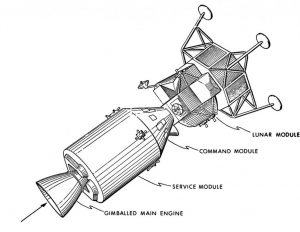 that a rocket could back onto the moon, he finally had to admit defeat. He called John Houbolt, and conceded the lunar landing design to Houbolt’s design, which was, as we all know, completely successful, because after all, his figures did not lie, and he did know what he was talking about. It was a great moment in history, and in Houbolt’s life, except for the fact that no one knew that the successful landing was his design. While the Lunar landing, 50 years ago was an amazing accomplishment, I find it quite sad that it took so many years for the world to know about how one man’s refusal to give up, actually made Lunar landing possible. We owe John Houbolt a great debt of gratitude, and it is more than 50 years overdue. Now that’s ludicrous!!
that a rocket could back onto the moon, he finally had to admit defeat. He called John Houbolt, and conceded the lunar landing design to Houbolt’s design, which was, as we all know, completely successful, because after all, his figures did not lie, and he did know what he was talking about. It was a great moment in history, and in Houbolt’s life, except for the fact that no one knew that the successful landing was his design. While the Lunar landing, 50 years ago was an amazing accomplishment, I find it quite sad that it took so many years for the world to know about how one man’s refusal to give up, actually made Lunar landing possible. We owe John Houbolt a great debt of gratitude, and it is more than 50 years overdue. Now that’s ludicrous!!

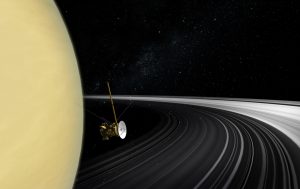 When we think of space exploration, I think most of us think about the moon or the International Space Station, but NASA has really done more exploring of other areas that it has of the moon. One such mission was NASA’s Cassini spacecraft, and the Huygens probe. Cassini launched in 1997, along with ESA’s Huygens probe. It was a joint endeavor of NASA, the European Space Agency, or ESA, and the Italian Space Agency. For six months in 2000, the spacecraft contributed to studies of Jupiter, before continuing on to its destination…Saturn, on June 30, 2004 and starting a string of flybys of Saturn’s moons. The Huygens probe was released later that year on Saturn’s moon Titan to conduct a study of the moon’s atmosphere and surface composition. In its second extended mission, Cassini made the first observations of a complete seasonal period for Saturn and its moons, flew between the rings and descended into the planet’s atmosphere.
When we think of space exploration, I think most of us think about the moon or the International Space Station, but NASA has really done more exploring of other areas that it has of the moon. One such mission was NASA’s Cassini spacecraft, and the Huygens probe. Cassini launched in 1997, along with ESA’s Huygens probe. It was a joint endeavor of NASA, the European Space Agency, or ESA, and the Italian Space Agency. For six months in 2000, the spacecraft contributed to studies of Jupiter, before continuing on to its destination…Saturn, on June 30, 2004 and starting a string of flybys of Saturn’s moons. The Huygens probe was released later that year on Saturn’s moon Titan to conduct a study of the moon’s atmosphere and surface composition. In its second extended mission, Cassini made the first observations of a complete seasonal period for Saturn and its moons, flew between the rings and descended into the planet’s atmosphere.
Upon arrival at Saturn, Cassini-Huygens began its mission by doing several flybys of Saturn’s moons. Saturn has at least 150 moons and moonlets in total, though only 62 have confirmed orbits and only 53 have been given official names. Every year, it seems, more moons are discovered. Most of the moons are small, icy bodies that probably broke off of Saturn’s impressive ring system. In fact, 34 of the moons that have been named are less than 7 miles in diameter while another 14 are 7 to 31 miles in diameter. However, some of its inner and outer moons are among the largest and most dramatic in the Solar System, measuring between 155 and 3106 miles in diameter and housing some of greatest mysteries in the Solar System. These moons aren’t all round, but rather have taken on several unusual and interesting shapes.
The rings of Saturn posed a particular problem if the Cassini was fly through them and descend into Saturn’s atmosphere. The rings of Saturn are the most extensive ring system of any planet in the Solar System. They consist of countless small particles, ranging in size from micrometers to meters, that orbit about Saturn. The ring particles are made almost entirely of water ice, with a trace component of rocky material. No one really 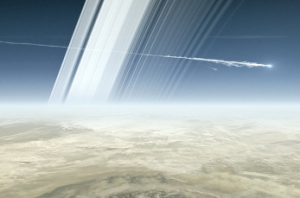
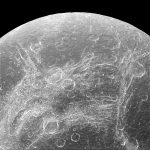 understands exactly how the rings are formed. Although theoretical models indicated that the rings were likely to have formed early in the Solar System’s history, new data from Cassini suggest they formed relatively late. That and several other things about Saturn are the reasons for its exploration. On September 15, 2017, twenty years after the Cassini-Huygens mission began, it was over, and Cassini began its Final Entry into Saturn’s Atmosphere…breaking up as it broke through.
understands exactly how the rings are formed. Although theoretical models indicated that the rings were likely to have formed early in the Solar System’s history, new data from Cassini suggest they formed relatively late. That and several other things about Saturn are the reasons for its exploration. On September 15, 2017, twenty years after the Cassini-Huygens mission began, it was over, and Cassini began its Final Entry into Saturn’s Atmosphere…breaking up as it broke through.
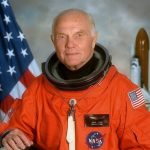
 Most of us who were around in the 1960s, know about the early space program, and especially the very first American to orbit the Earth…John Glenn. John Glenn’s historic flight put the United States on the map of the space race, so to speak. It all seems very commonplace in this day and age of space shuttles, and the International Space Station, but the reality was that this first American orbit could have ended tragically.
Most of us who were around in the 1960s, know about the early space program, and especially the very first American to orbit the Earth…John Glenn. John Glenn’s historic flight put the United States on the map of the space race, so to speak. It all seems very commonplace in this day and age of space shuttles, and the International Space Station, but the reality was that this first American orbit could have ended tragically.
While some change had happened concerning blacks and women, there was still much that had not changed. Women were not viewed as mathematically inclined, and black women even less so. That was before they knew about Katherine Johnson. Katherine Johnson was handpicked to be one of three black students to integrate West Virginia’s graduate schools. Born in White Sulphur Springs, West Virginia in 1918, her intense curiosity and brilliance with numbers vaulted her ahead several grades in school. She graduated from high school at the age of 14, and the historically black West Virginia State University at 18, where she had made quick work of the school’s math curriculum. Katherine graduated with highest honors in 1937 and took a job teaching at a black public school in Virginia, but this was not to be her career.
In 1935, the NACA (National Advisory Committee for Aeronautics, a precursor to NASA) hired five women to be their first computer pool at the Langley campus. “The women were meticulous and accurate…and they didn’t have to pay them very much,” NASA’s historian Bill Barry says, explaining the NACA’s decision. Six months later, after the attack on Pearl Harbor brought the United States into World War II, NACA and Langley began recruiting African-American women with college degrees to work as human computers.
Johnson was hired by NACA in 1953. Johnson, along with Dorothy Vaughan, and Mary Jackson, became part of NASA’s team of human computers. These people were mathematicians who performed the necessary calculations to make space flight possible in a time when “machine computers” didn’t exist, or were very new. Johnson was perfect for this job. After working for Nasa a while, and really proving her worth, Johnson was still running into road blocks. When NASA engineer Paul Stafford was preparing a meeting about John Glenn’s upcoming mission. Johnson felt that she needed to be at that meeting to explain her numbers, but Stafford refused her the request to attend stating, “There’s no protocol for women attending.” Johnson instantly replied, “There’s no protocol for a man circling Earth either, sir.”
Johnson saw an opportunity when NASA installed huge IBM computers…that no one knew how to use. They tried to get the machines set up so that the human computers could be replaced by the far more accurate machines, but the set up proved too difficult, until Johnson taught herself to use the machines. She then taught the rest of the black women, human computers to run them too. In the end, they were the only ones who knew how to do it. It made them much more important to the space program. The men had to face the fact that the women, that they had all but discounted, were going to be the ones to save the space program.
The biggest highlight of Katherine Johnson’s career came at the point when John Glenn was getting ready to  make that historic first orbit around the Earth. Johnson’s main job in the lead-up and during the mission was to double-check and reverse engineer the newly-installed IBM 7090s trajectory calculations. There were very tense moments during the flight that forced the mission to end earlier than expected. John Glenn requested that Johnson specifically check and confirm trajectories and entry points that the IBM put out. Glenn didn’t completely trust the computer. So, he asked the head engineers to “get the girl to check the numbers…If she says the numbers are good…I’m ready to go.” Johnson couldn’t have been given a greater seal of approval than to have John Glenn say that she was the only one he trusted…after all, it was his life.
make that historic first orbit around the Earth. Johnson’s main job in the lead-up and during the mission was to double-check and reverse engineer the newly-installed IBM 7090s trajectory calculations. There were very tense moments during the flight that forced the mission to end earlier than expected. John Glenn requested that Johnson specifically check and confirm trajectories and entry points that the IBM put out. Glenn didn’t completely trust the computer. So, he asked the head engineers to “get the girl to check the numbers…If she says the numbers are good…I’m ready to go.” Johnson couldn’t have been given a greater seal of approval than to have John Glenn say that she was the only one he trusted…after all, it was his life.
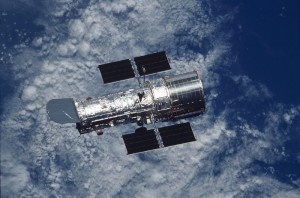 When most of us think of outer space, we think of a place that is quiet and still, like floating through a vacuum. I suppose that some of that is true, but while things do float around in space, they can also crash into other things floating in space. I don’t know if collisions in space make a sound, but I suspect they do. I don’t know how two objects can collide quietly, but maybe the sound does occur, and then doesn’t carry. Whether there is a sound or not, those space collisions are not soft hits, and damage can occur.
When most of us think of outer space, we think of a place that is quiet and still, like floating through a vacuum. I suppose that some of that is true, but while things do float around in space, they can also crash into other things floating in space. I don’t know if collisions in space make a sound, but I suspect they do. I don’t know how two objects can collide quietly, but maybe the sound does occur, and then doesn’t carry. Whether there is a sound or not, those space collisions are not soft hits, and damage can occur.
After NASA first put the Hubble telescope in orbit in 1990, scientists realized that the telescope’s primary mirror had a flaw called spherical aberration. Basically, the outer edge of the mirror was ground too flat by a depth of 2.2 microns. That is about as thick as one-fiftieth the thickness of a human hair. I don’t know how that could make much difference, but this aberration resulted in images that were fuzzy because some of the light from the objects being studied was being scattered. While this was not caused by other objects in space, it had to be repaired anyway. The Corrective Optics Space Telescope Axial Replacement, or COSTAR, was developed as an effective means of countering the effects of the flawed shape of the mirror. COSTAR was a telephone booth sized instrument which placed 5 pairs of corrective mirrors, some as small as a nickel coin, in front of the Faint Object Camera, the Faint Object Spectrograph and the Goddard High Resolution Spectrograph. The fix worked, and while this was not the only repair job done on the Hubble Telescope, it was the first.
NASA arranged a repair mission SM1, or Shuttle Mission: STS-61 to make the repair. The mission took place on 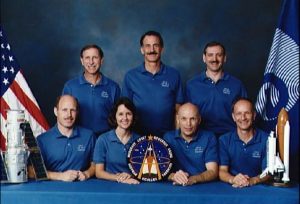 December 2-13, 1993 in the Shuttle Endeavor. The mission, however, was not just to fix a flaw in the original design, which would have been logical when we think of how much we depend on the Hubble Telescope, but the crew also installed and replaced other components including: Solar Arrays, Solar Array Drive Electronics (SADE), Magnetometers, Coprocessors for the flight computer, Two Rate Sensor Units, Two Gyroscope Electronic Control Units, and a GHRS Redundancy Kit. The crew included Commander Richard O. Covey, Pilot Kenneth D. Bowersox, Payload Commander F. Story Musgrave and Mission Specialists Kathryn C. Thornton, Claude Nicollier, Jeffrey A. Hoffman and Tom Akers. The mission successfully made the repairs to Hubble.
December 2-13, 1993 in the Shuttle Endeavor. The mission, however, was not just to fix a flaw in the original design, which would have been logical when we think of how much we depend on the Hubble Telescope, but the crew also installed and replaced other components including: Solar Arrays, Solar Array Drive Electronics (SADE), Magnetometers, Coprocessors for the flight computer, Two Rate Sensor Units, Two Gyroscope Electronic Control Units, and a GHRS Redundancy Kit. The crew included Commander Richard O. Covey, Pilot Kenneth D. Bowersox, Payload Commander F. Story Musgrave and Mission Specialists Kathryn C. Thornton, Claude Nicollier, Jeffrey A. Hoffman and Tom Akers. The mission successfully made the repairs to Hubble.
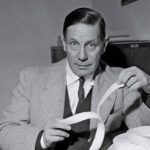 The inspiration for inventions comes from many different sources, and things we would never think could turn into something great, can surprise you. Swiss electrical engineer, George De Mestral had gone for a walk in the woods with his dog, When they got back, De Mestral found himself fascinated with the cockleburs that he had to pull off of his dog. After taking a walk in the woods with his dog, was fascinated by the cockleburs’ ability to cling to his clothes and his dog’s fur. For many dog owners cockleburs are a good reason to grumble. When their pets play outside and return with all sorts of nature stuck to their fur and feet, bringing the outside environment into their once-clean homes, people get annoyed. Nevertheless, not everyone saw this as a big problem.
The inspiration for inventions comes from many different sources, and things we would never think could turn into something great, can surprise you. Swiss electrical engineer, George De Mestral had gone for a walk in the woods with his dog, When they got back, De Mestral found himself fascinated with the cockleburs that he had to pull off of his dog. After taking a walk in the woods with his dog, was fascinated by the cockleburs’ ability to cling to his clothes and his dog’s fur. For many dog owners cockleburs are a good reason to grumble. When their pets play outside and return with all sorts of nature stuck to their fur and feet, bringing the outside environment into their once-clean homes, people get annoyed. Nevertheless, not everyone saw this as a big problem.
When De Mestral looked at the cockleburs under a microscope, he saw the tons of tiny hooks that line cockleburs and discovered they could easily attach to the small loops found in clothing and fur. De Mestral saw this as a opportunity to invent something useful. He experimented with different materials to make his own hooks and loops form a stronger bond. In 1955, after much trial and error, De Mestral decided nylon was perfect and thus Velcro was invented. These days, Velcro is a vital part of everyday life. We use it all the time, and give no thought to life without it.
The word Velcro is a combination of the words “velvet” and “crochet,” and was showcased in a 1959 fashion  show held at the Waldorf-Astoria Hotel in New York City. However, it didn’t receive positive reviews from fashion enthusiasts. I’m sure they thought it would snag material, and pull hair, which it can do, but its positive uses far outweigh its negative issues. Nevertheless, Velcro wasn’t widely used until NASA made it popular in the early 1960s. Apollo astronauts used it to secure items that they didn’t want escaping in their zero-gravity environment. Hospitals and athletic companies eventually used Velcro after realizing the practicality of the material. In 1968, Puma was the first to use Velcro on shoes. Adidas, Reebok, and others followed suit. Today it is used in many things, including the blood pressure cuff. it has simplified our lives immensely, and to think that it was invented by accident.
show held at the Waldorf-Astoria Hotel in New York City. However, it didn’t receive positive reviews from fashion enthusiasts. I’m sure they thought it would snag material, and pull hair, which it can do, but its positive uses far outweigh its negative issues. Nevertheless, Velcro wasn’t widely used until NASA made it popular in the early 1960s. Apollo astronauts used it to secure items that they didn’t want escaping in their zero-gravity environment. Hospitals and athletic companies eventually used Velcro after realizing the practicality of the material. In 1968, Puma was the first to use Velcro on shoes. Adidas, Reebok, and others followed suit. Today it is used in many things, including the blood pressure cuff. it has simplified our lives immensely, and to think that it was invented by accident.
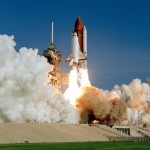 September 17, 1976 was an epic day in American history, and truly in world history as well. This was the day that the seemingly impossible became possible. Man had been in space many times by that date, but the crafts taken were disposable, and the cost to build new ones was great. It would be an amazing thing to have a craft that could take man into space, and then make a smooth landing back on Earth. It was unheard of, but it was no longer impossible.
September 17, 1976 was an epic day in American history, and truly in world history as well. This was the day that the seemingly impossible became possible. Man had been in space many times by that date, but the crafts taken were disposable, and the cost to build new ones was great. It would be an amazing thing to have a craft that could take man into space, and then make a smooth landing back on Earth. It was unheard of, but it was no longer impossible.
On this day in 1976, NASA publicly unveiled its first space shuttle. The shuttle was called Enterprise, and during a ceremony in Palmdale, California, the world got its first glimpse of the future. The Space Shuttle looked like an airplane. Its development cost almost $10 billion and took nearly a decade. The shuttle would not actually fly until 1977. Enterprise became the first space shuttle to fly freely when it was lifted to a height of 25,000 feet by a Boeing 747 airplane and then released, gliding back to Edwards Air Force Base on its own accord. It was a phenomenal accomplishment. What an exciting event in NASA history!!
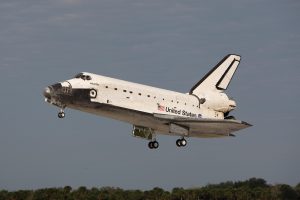
With the success of the first flight, came regular flights of the space shuttle, which began on April 12, 1981, with the launching of Columbia from Cape Canaveral, Florida. The shuttle had to be able to get into space, and so it was launched by two solid-rocket boosters and an external tank. These were ejected prior to the actual entrance into space, and only the shuttle, which looked like an actual airplane, entered into orbit around Earth. When the two-day mission was completed, the shuttle fired its engines to reduce speed and, after descending through the atmosphere, landed like a glider at California’s Air Force Base…brought to a stop with the help of three parachutes.
Early shuttles took satellite equipment into space and carried out various scientific experiments. On January 28, 1986, NASA and the space shuttle program suffered a major setback when the Challenger exploded 74 seconds after takeoff and all seven people aboard were killed. That was a horrible day in shuttle history. After changing the things that caused the problem, the shuttle flew again beginning in September 1988, when Discovery went up successfully. Since 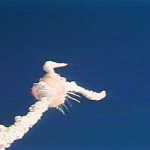 then, the space shuttle has carried out numerous important missions, such as the repair and maintenance of the Hubble Space Telescope and the construction and manning of the International Space Station. A tragedy in space again rocked the nation on February 1, 2003, when Columbia, on its 28th mission, disintegrated during re-entry of the earth’s atmosphere. All seven astronauts aboard were killed. In the aftermath, the space-shuttle program was grounded until Discovery returned to space in July 2005, amid concerns that the problems that had downed Columbia had not yet been fully solved. On July 21, 2011, Space Shuttle Atlantis touched down for the final time, at the end of STS-135, with the official retirement of NASA’s Space Shuttle fleet taking place from March to July 2011.
then, the space shuttle has carried out numerous important missions, such as the repair and maintenance of the Hubble Space Telescope and the construction and manning of the International Space Station. A tragedy in space again rocked the nation on February 1, 2003, when Columbia, on its 28th mission, disintegrated during re-entry of the earth’s atmosphere. All seven astronauts aboard were killed. In the aftermath, the space-shuttle program was grounded until Discovery returned to space in July 2005, amid concerns that the problems that had downed Columbia had not yet been fully solved. On July 21, 2011, Space Shuttle Atlantis touched down for the final time, at the end of STS-135, with the official retirement of NASA’s Space Shuttle fleet taking place from March to July 2011.

